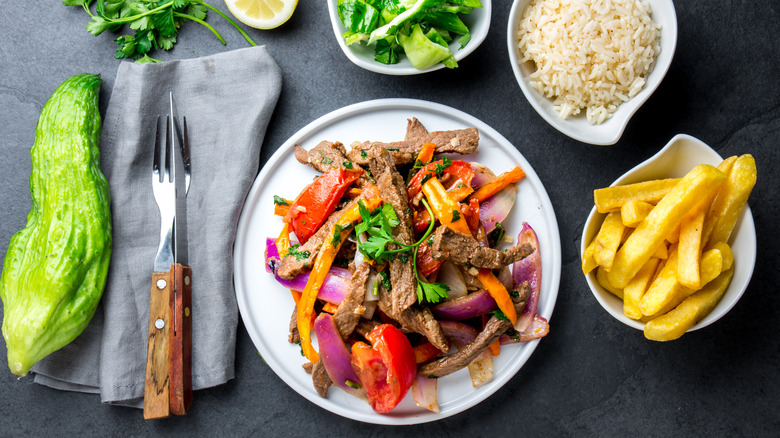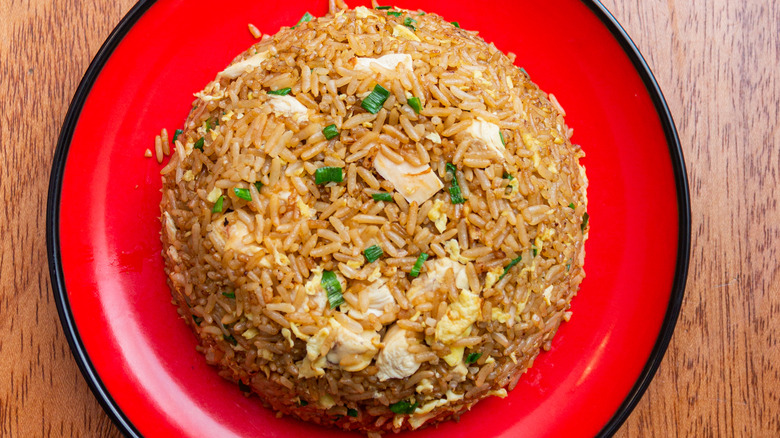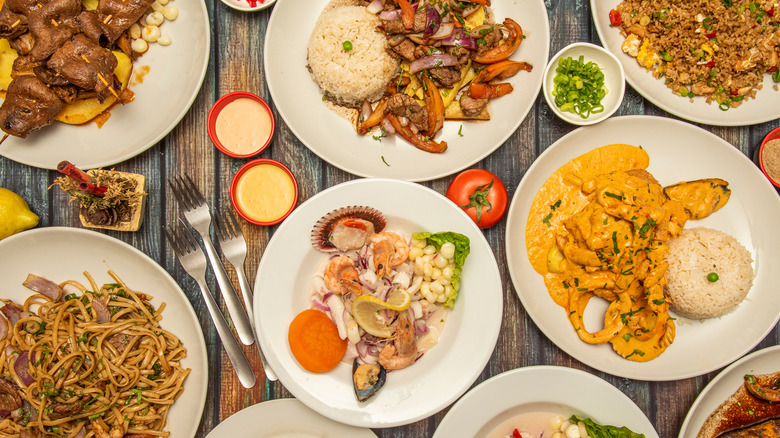Chifa: The Peruvian-Chinese Fusion Cuisine You Need To Try
Some classics of Peruvian cuisine have roots in Chinese cooking. It started in 1849 when China sent laborers to Peru, which was one of the first Latin American nations to flourish at this time. Many of the Chinese immigrant workers paired off with native Peruvians, creating mixed lineages and a new mix of cultures. Eat Peru reports that, those who decided to stay in Peru when their eight-year work contracts were complete, opened up Chinese restaurants called Chi Fá, which means "to eat rice" in Cantonese.
The Chinese laborers were rewarded with sacks of rice, a crop that originated in China but was already being cultivated in South America since the 17th century, when Spanish and Portuguese traders brought long-grain rice to the Americas, according to Harold McGee's "On Food and Cooking." Rice was the most accessible, affordable ingredient and a staple in their culture's cuisine. Per The Diplomat, the second large wave of Chinese immigrants arrived in Peru a century later but comprised chiefly of educated, elite business owners from Taiwan. The existing Chinese Peruvians have become somewhat difficult to trace due to name changes, issues of discrimination, and illiteracy. But now, descendants of the first Chinese immigrants take pride in their complex heritage. Chifa is one of the lasting results of this earlier wave of immigration, and it reveals the ingenuity of those who combined cooking techniques and ingredients from the two cultures.
Primary Chifa ingredients
Of course, rice is at the center of Chifa cuisine, as it was for many cultures in Latin America. The Chinese immigrants used the ingredients they brought to Peru, notably ginger, scallions, and soy sauce (via Eat Peru). The Chinese also brought along egg noodles, which gave way to other stir-fry dishes. Not only were Chinese ingredients used in emergent Chifa cuisine, but so were their cooking tools and techniques, which changed the way certain Peruvian dishes were prepared. The wok was used for frying meats and vegetables at scalding temperatures, giving them a golden char and imbuing Chifa dishes with their signature wok hei flavor.
The proteins of choice were usually whatever was available and affordable. Many Chifa dishes include a variety of seafood, beef, or chicken. Eat Peru states that chicken used to be a more expensive ingredient, so the immigrants opted for scraps of beef and pork instead. Of course, as The Culture Trip shows, Chifa food is distinct for its medley of Chinese and Peruvian ingredients: we can find vegetables or spices native to Peru, like potatoes, pineapple, and aji amarillo (a sauce made from a Peruvian chili pepper).
Classic Chifa dishes
Although you can obviously find Chifa restaurants in Lima, dishes like lomo saltado and arroz chaufa have become classics at mainstream Peruvian restaurants, according to New Worlder. Lomo saltado is a salty, meaty stir-fry dish made of beef strips, onions, bell peppers, and potatoes. The sauce comes together with soy sauce and vinegar, giving this heavy dish a sharp and salty profile that requires a bed of white rice for balance.
Arroz chaufa, another classic example of Chifa cuisine, is a fried rice dish served with almost every entrée. Like other types of fried rice, arroz chaufa can include various proteins, but the most common are a seafood medley, chicken, or pork (via El Mesōn). There is also Tallarín saltado, a noodle stir-fry dish seasoned with soy sauce, ginger, and pepper. Egg noodles are tossed together with meat, onions, bell peppers, and some sliced scallions to make a dish that's similar to chow mein.
Trafalgar notes that no matter the dish, anything you get at a Chifa restaurant usually comes in huge portions meant for sharing. A classic Chifa table spread would have some form of stir-fried meat and arroz chaufa to share, as well as cans of Inca Kola for everyone to sip on. Although the iconic Inca Kola isn't Chinese, it's the perfect bubble gum-flavored soda to help wash down the rich saltado (via Eat Peru).


